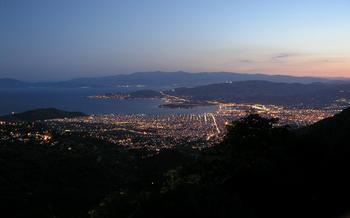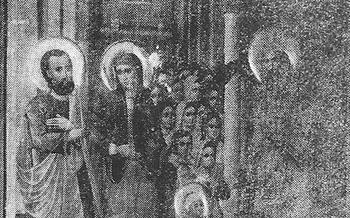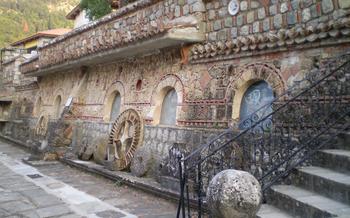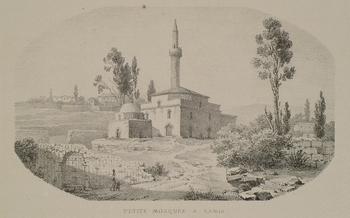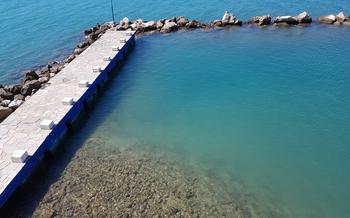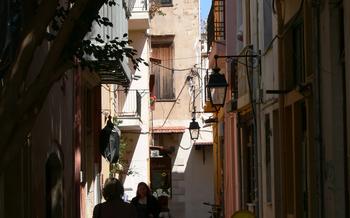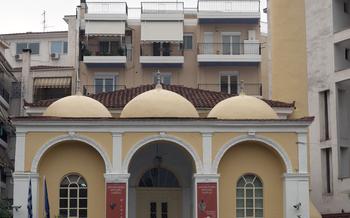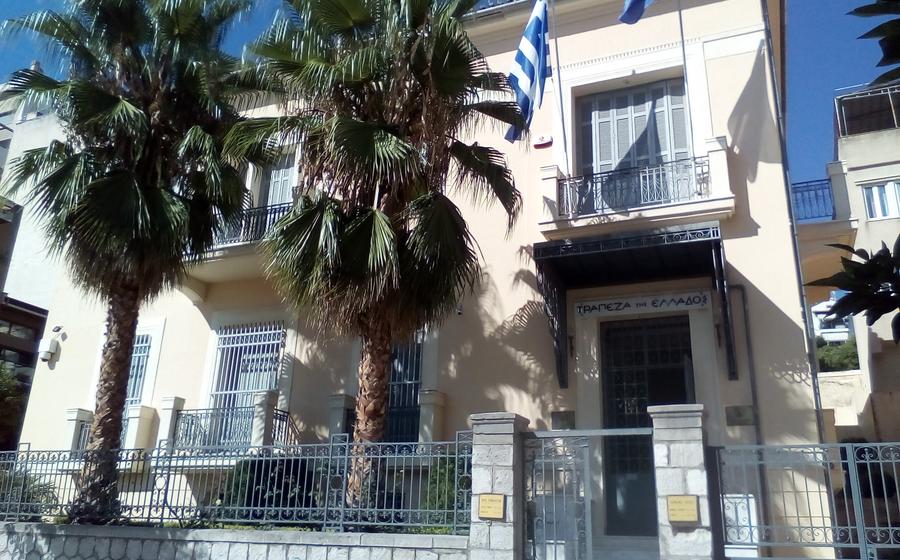
Agios Georgios Church
- Historical Significance
- Location and Accessibility
- Interior Features
- Exterior Architecture
- Cultural Importance
- Renovation and Preservation Efforts
- Surrounding Area
- Photography and Videography
- Dress Code and Etiquette
- Accessibility for Visitors
- Local Festivals and Celebrations
- Local Cuisine and Restaurants
- Historical Context and Legends
- Insider Tip
Historical Significance
The Agios Georgios Church, or Church of Saint George, holds a significant position in the history and religious identity of Lamia. It was constructed during the 19th century, serving as a sacred place of worship for the Greek Orthodox community. The church played a vital role in preserving and promoting the Orthodox faith, becoming an integral part of the city's cultural and spiritual landscape. Its historical significance extends beyond its religious function; the church stands as a testament to the enduring traditions and devotion of the Greek Orthodox community in Lamia. The architectural style of the church is a blend of Byzantine and neoclassical elements, showcasing the diverse influences that have shaped Greek architecture throughout history.
Location and Accessibility
The Agios Georgios Church is conveniently located in the heart of Lamia, at the intersection of Vasileos Konstantinou and Athanasiou Diakou streets. Its prominent position makes it easily accessible on foot, allowing visitors to explore the surrounding area and immerse themselves in the city's vibrant atmosphere.
To reach the church by public transportation, visitors can take the local bus line 5, which stops just a few steps away. Alternatively, the church is a short walk from the Lamia Railway Station, making it an ideal destination for those arriving by train.
For those traveling by car, there are several parking options available nearby. The closest parking lot is located on Vasileos Konstantinou Street, just a minute's walk from the church. Additionally, street parking is available in the surrounding area, subject to availability.
To avoid crowds and experience the church in its tranquility, it is recommended to visit outside of peak hours, such as early mornings or late afternoons. However, if you seek to witness the church's lively atmosphere, attending a religious service or event is highly recommended, providing an immersive experience into the local religious customs.
Interior Features
Inside the Agios Georgios Church, visitors are greeted by a stunning array of religious artifacts and decorative elements that reflect the richness of Greek Orthodox tradition. The most striking feature is the intricate iconostasis, a wall of icons that separates the nave from the sanctuary. Each icon is a masterpiece of religious art, depicting scenes from the life of Christ, the Virgin Mary, and various saints.
The chandeliers hanging from the high ceiling add a touch of grandeur to the church's interior. Made of shimmering crystal and adorned with intricate metalwork, they cast a warm glow on the surrounding space, creating an atmosphere of reverence and awe. Other notable ornaments include the beautifully carved wooden pews, the ornate pulpit, and the delicate stained glass windows that bathe the interior in colorful light.
The interior decorations of the Agios Georgios Church are not merely aesthetic embellishments; they hold deep cultural and symbolic significance. The icons, for example, serve as a visual representation of the saints and their stories, providing a tangible connection between the faithful and the divine. The symbolism of the iconostasis, with its three doors representing the Holy Trinity, reinforces the sacred nature of the space.
Overall, the interior of the Agios Georgios Church is a testament to the enduring power of faith and the artistic traditions of Greek Orthodoxy. It is a place where visitors can find solace, inspiration, and a deeper connection to the divine.
Exterior Architecture
Distinguished by its grand and intricate exterior, the Agios Georgios Church displays an amalgamation of architectural styles that encapsulates different periods of history. The towering bell tower, a prominent feature of the church, stands tall and majestic, inviting visitors to marvel at its architectural grandeur. Its intricate carvings and ornamental designs showcase the artistry and craftsmanship of skilled builders.
The church's dome, an architectural masterpiece, exhibits a seamless blend of Byzantine and Ottoman influences. Its graceful curves and elegant proportions create a harmonious balance that complements the overall design. The exterior walls are adorned with intricate stonework, featuring decorative motifs and biblical scenes. These intricate carvings narrate tales from the Bible, offering visitors a glimpse into the rich history and religious significance of the church.
The Agios Georgios Church stands as a testament to the architectural prowess of its builders. Its diverse design elements, spanning different eras and cultures, create a cohesive and awe-inspiring structure that captures the essence of Greek Orthodox architecture.
Cultural Importance
The Agios Georgios Church holds immense cultural significance, deeply intertwined with the traditions and customs of Lamia and the surrounding region. For centuries, it has served as a spiritual and communal hub for the Greek Orthodox community, fostering a sense of unity and belonging. The church's architectural design, intricate iconography, and religious artifacts embody the rich history and beliefs of the Greek Orthodox faith.
Beyond its religious significance, the Agios Georgios Church is a symbol of cultural heritage and identity for the people of Lamia. It has witnessed countless baptisms, weddings, funerals, and other important life events, becoming an integral part of the local community's collective memory. The church's enduring presence has shaped the cultural landscape of Lamia, influencing local customs, folklore, and artistic expressions.
Renovation and Preservation Efforts
Over the years, the Agios Georgios Church has undergone several restoration and preservation projects to maintain its historical integrity. In the early 20th century, extensive repairs were carried out to address structural issues and restore the church's original architectural features. Skilled craftsmen and artisans used traditional techniques and materials to preserve the church's unique character.
In the 1960s, a comprehensive renovation project was undertaken to address the deterioration caused by time and weather. This included cleaning and restoring the interior frescoes, repairing the roof and bell tower, and reinforcing the foundation. The project aimed to safeguard the church's artistic and historical value while ensuring its continued use as a place of worship.
More recently, in the 1990s, another restoration project focused on preserving the church's interior decorations. Experts meticulously cleaned and restored the icons, frescoes, and chandeliers, bringing back their vibrant colors and intricate details. These efforts have ensured that the church's interior remains a testament to the artistry and craftsmanship of its creators.
Through these dedicated renovation and preservation efforts, the Agios Georgios Church has been successfully preserved as a living monument to Greek Orthodox faith and culture. The church's historical significance and architectural beauty continue to inspire visitors and locals alike, serving as a reminder of the enduring legacy of Greek Orthodox Christianity.
Surrounding Area
Within the vicinity of the Agios Georgios Church, a myriad of notable landmarks and attractions await exploration. Just a stone's throw away, the picturesque Lamia Archaeological Museum stands as a testament to the region's rich historical heritage, housing a captivating collection of artifacts that unveil the captivating stories of the past. Delve into the depths of history as you wander through the museum's exhibits, tracing the footsteps of ancient civilizations that once thrived in this very land.
Continuing your journey, uncover the natural wonders that surround the church. The enchanting "Lefka Spilia" (White Cave) beckons with its alluring subterranean beauty, inviting you to marvel at the intricate stalactite and stalagmite formations that adorn its chambers. Embark on a spelunking adventure and discover the hidden depths of this underground paradise.
For those seeking a tranquil escape, the serene Loutra Ypatis Thermal Springs offer a rejuvenating experience. Immerse yourself in the warm, mineral-rich waters and let your worries melt away as you bask in the embrace of nature's healing touch.
Venturing further afield, the picturesque village of Granitsa beckons with its traditional charm and captivating history. Wander through its cobbled streets, admiring the well-preserved stone houses and soaking up the village's timeless atmosphere. As you explore, uncover the secrets of the renowned "Granitsa School," a renowned center of ecclesiastical art that flourished during the 17th and 18th centuries, leaving an indelible mark on the region's cultural heritage.
Photography and Videography
Photography and videography are permitted inside the Agios Georgios Church, but visitors are kindly requested to be respectful of the sacred space and avoid disturbing worshippers or religious ceremonies. The best time to capture the church's beauty is during the golden hours of sunrise or sunset, when the natural light casts a warm glow on the exterior. Tripods are allowed, but flash photography is discouraged to preserve the integrity of the artwork and artifacts. Visitors should also be mindful of the privacy of other visitors and refrain from taking photos or videos of individuals without their consent.
Dress Code and Etiquette
When visiting the Agios Georgios Church, it is essential to observe appropriate attire and behavior to show respect for the sacred space. Modest clothing is recommended, covering shoulders and knees for both men and women. Shorts, tank tops, or revealing clothing are considered inappropriate. Visitors should avoid wearing loud or flashy colors or patterns that might distract from the solemnity of the church.
During religious services or events, it is customary to stand during the reading of the gospel and the Lord's Prayer and to bow or make the sign of the cross during specific prayers or blessings. Visitors should refrain from talking, laughing, or making noise that might disturb the worshippers. Taking photos or videos inside the church is generally allowed, but it is important to be discreet and not use flash photography or tripods that might obstruct others' views.
Accessibility for Visitors
The Agios Georgios Church welcomes visitors from all backgrounds and abilities. The church is wheelchair accessible, with ramps located at the main entrance and throughout the interior. Guided tours are available upon request, and audio guides in multiple languages are provided for a more immersive experience. Families with young children or infants are welcome, and there are designated areas for strollers and diaper changing. The church staff is friendly and accommodating, ensuring that all visitors have a comfortable and meaningful experience.
Local Festivals and Celebrations
The Agios Georgios Church is not only a place of worship but also a focal point for local festivals and celebrations. Each year, the church hosts several events that draw visitors from near and far. One of the most significant is the annual feast day of Saint George, which takes place on April 23rd. During this festival, the church is decorated with colorful flowers and lights, and a special service is held in honor of the saint. Visitors can witness traditional Greek dancing, music, and food, as well as participate in various cultural activities. Other notable events include the Easter celebration, with its elaborate processions and rituals, and the Christmas Eve service, where locals gather to sing carols and exchange gifts. These festivals provide a unique opportunity for visitors to experience the vibrant traditions and customs of the Greek Orthodox faith and immerse themselves in the local culture.
Local Cuisine and Restaurants
After a visit to the Agios Georgios Church, travelers seeking culinary adventures can delight in the diverse and flavorful dishes that Lamia has to offer. In the vicinity of the church, visitors will find an array of restaurants, cafes, and tavernas, each offering a tantalizing glimpse into the region's rich culinary traditions.
For a taste of authentic Greek cuisine, try "To Patriko Mas" restaurant, known for its mouthwatering souvlaki and traditional Greek dishes prepared with fresh, local ingredients. Alternatively, indulge in the delectable seafood creations at "To Kyma," a charming restaurant with a breathtaking view of the Lamia Gulf, offering a delightful fusion of flavors from the sea.
Vegetarians and vegans will find a haven at "Fyto," a charming establishment that specializes in plant-based cuisine, showcasing the bounty of fresh vegetables, herbs, and grains from the region. For a sweet treat, head to "Glyka tou Koutali," a traditional Greek pastry shop renowned for its exquisite baklava, kataifi, and other delectable desserts.
No matter your culinary preferences, Lamia offers a delectable journey through the tastes and flavors of Greece, ensuring a memorable and satisfying experience for every palate.
Historical Context and Legends
The Agios Georgios Church has been the subject of many stories and legends over the centuries. One of the most popular tales is that of the miraculous healing of a young boy. According to legend, the boy was born with a severe illness and was brought to the church by his parents in the hope of a cure. The priest prayed over the boy and anointed him with holy oil, and the boy was miraculously healed. The grateful parents left a votive offering in the church, which can still be seen today.
Another legend tells of the time when the church was attacked by pirates. The pirates were about to set fire to the church when a sudden storm arose, driving them away. The people of Lamia believed that this was a miracle performed by Saint George, and they celebrated the event with a feast day that is still held every year on November 23rd.
Insider Tip
For a unique perspective, climb the bell tower of the Agios Georgios Church for breathtaking panoramic views of Lamia and the surrounding countryside. The climb is not for the faint of heart, as the stairs are narrow and steep, but the reward is worth the effort. From the top, you'll be able to see the city's rooftops, the sprawling valley, and the distant mountains. It's a magical experience, especially at sunset when the sky is awash in warm hues of orange and pink. Remember to bring your camera to capture the stunning vistas.


